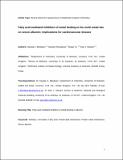Files in this item
Fatty acid-mediated inhibition of metal binding to the multi-metal site on serum albumin : implications for cardiovascular disease
Item metadata
| dc.contributor.author | Blindauer, Claudia A. | |
| dc.contributor.author | Khazaipoul, Siavash | |
| dc.contributor.author | Yu, Ruitao | |
| dc.contributor.author | Stewart, Alan J. | |
| dc.date.accessioned | 2017-02-17T00:32:29Z | |
| dc.date.available | 2017-02-17T00:32:29Z | |
| dc.date.issued | 2016 | |
| dc.identifier | 200748581 | |
| dc.identifier | 21f1f0dc-0f54-49ae-874a-abf55069a4c8 | |
| dc.identifier | 84989238704 | |
| dc.identifier | 000385563100002 | |
| dc.identifier.citation | Blindauer , C A , Khazaipoul , S , Yu , R & Stewart , A J 2016 , ' Fatty acid-mediated inhibition of metal binding to the multi-metal site on serum albumin : implications for cardiovascular disease ' , Current Topics in Medicinal Chemistry , vol. 16 , no. 27 , pp. 3021-3032 . https://doi.org/10.2174/1568026616666160216155927 | en |
| dc.identifier.issn | 1568-0266 | |
| dc.identifier.other | ORCID: /0000-0003-4580-1840/work/60195769 | |
| dc.identifier.uri | https://hdl.handle.net/10023/10310 | |
| dc.description.abstract | Human serum albumin (HSA) is the major protein in blood plasma and is responsible for circulatory transport of a range of small molecules including fatty acids, metal ions and drugs. We previously identified the major plasma Zn2+ transport site on HSA and revealed that fatty-acid binding (at a distinct site called the FA2 site) and Zn2+ binding are interdependent via an allosteric mechanism. Since binding affinities of long-chain fatty acids exceed those of plasma Zn2+, this means that under certain circumstances the binding of fatty acid molecules to HSA is likely to diminish HSA Zn2+-binding, and hence affects the control of circulatory and cellular Zn2+ dynamics. This relationship between circulatory fatty acid and Zn2+ dynamics is likely to have important physiological and pathological implications, especially since it has been recognised that Zn2+ acts as a signalling agent in many cell types. Fatty acid levels in the blood are dynamic, but most importantly, chronic elevation of plasma fatty acid levels is associated with some metabolic disorders and disease states – including myocardial infarction and other cardiovascular diseases. In this article, we briefly review the metal-binding properties of albumin and highlight the importance of their interplay with fatty acid binding. We also consider the impact of this dynamic link upon levels and speciation of plasma Zn2+, its effect upon cellular Zn2+ homeostasis and its relevance to cardiovascular and circulatory processes in health and disease. | |
| dc.format.extent | 12 | |
| dc.format.extent | 914912 | |
| dc.language.iso | eng | |
| dc.relation.ispartof | Current Topics in Medicinal Chemistry | en |
| dc.subject | Allostery, circulation, fatty acid | en |
| dc.subject | Protein-lipid interactions | en |
| dc.subject | Protein-metal interactions | en |
| dc.subject | Serum albumin | en |
| dc.subject | R Medicine | en |
| dc.subject | T-NDAS | en |
| dc.subject | SDG 3 - Good Health and Well-being | en |
| dc.subject.lcc | R | en |
| dc.title | Fatty acid-mediated inhibition of metal binding to the multi-metal site on serum albumin : implications for cardiovascular disease | en |
| dc.type | Journal article | en |
| dc.contributor.sponsor | BBSRC | en |
| dc.contributor.institution | University of St Andrews. School of Medicine | en |
| dc.contributor.institution | University of St Andrews. Institute of Behavioural and Neural Sciences | en |
| dc.contributor.institution | University of St Andrews. Biomedical Sciences Research Complex | en |
| dc.identifier.doi | https://doi.org/10.2174/1568026616666160216155927 | |
| dc.description.status | Peer reviewed | en |
| dc.date.embargoedUntil | 2017-02-16 | |
| dc.identifier.grantnumber | BB/J006467/1 | en |
This item appears in the following Collection(s)
Items in the St Andrews Research Repository are protected by copyright, with all rights reserved, unless otherwise indicated.

